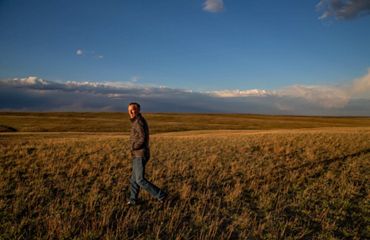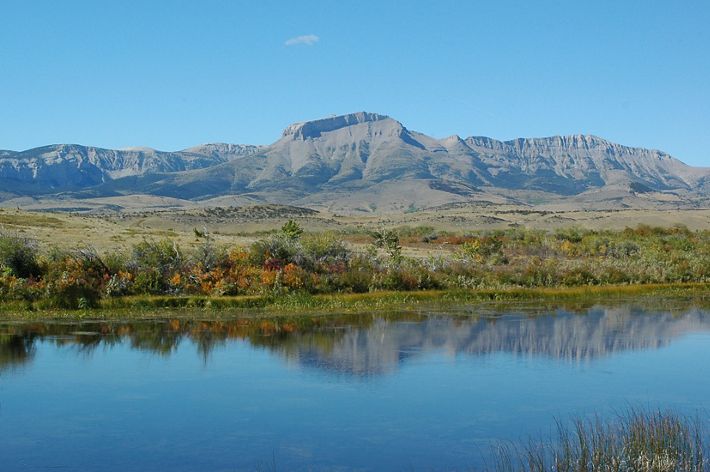
Boots on the Ground
Conservationists make the case that veterans can have a career in the environment and a home in nature.
Fall 2019
Fred Napoleon is the first to arrive at the ranch. Nicely dressed in a sweater and carrying boxed wine as a hospitality gift, he’s the only one whose flight to Montana wasn’t delayed.
Napoleon, a retired Army soldier who deployed in the first Gulf War, is one of 11 veterans gathering at Pine Butte—a remote former guest ranch in western Montana now owned by The Nature Conservancy. He sits in the kitchen as the organizers of this gathering, a fly-fishing retreat, scurry around making lunch sandwiches and final preparations.
Outside, it’s calmer. There’s dense white smoke to the west from the forest fires burning this August. It obscures the afternoon sun over the mountains of the Bob Marshall Wilderness—a spread of more than 1 million acres of forests, alpine lakes and meadows. This is grizzly bear country, and one of the organizers hands Napoleon a can of bear spray before directing him to his sleeping cabin.
Back in the kitchen, the three organizers scramble. They are TNC staffers, but everything they’re doing here is on top of their day jobs: Brent Lathrop, who served in the Army as a reservist from the Vietnam era through the Gulf War, is a director of TNC’s work in southeast Wyoming. Kaylee Kenison is a former Iraq War medic who handles operations for TNC’s Montana chapter. Michelle Kotulski, an e-learning developer and the wife of a career Marine, flew all the way from Hawaii and has been awake for 36 hours straight.
They’re part of a larger team that has taken on something of a second job advocating for veterans who work for TNC and helping connect the organization with veterans in general. They call themselves Veterans in Nature’s Service, or VINS for short, and they’re one of several specialized employee groups that have emerged at the organization in the past seven years.
This week the group is partnering with a veterans’ service organization called Project Healing Waters Fly Fishing to bring former military personnel to this corner of Montana for a guided fly-fishing retreat. Project Healing Waters teaches veterans living with disabilities how to tie flies and catch fish at similar gatherings all over the United States. This week, they have been invited to fish the preserve, but it is only the second such retreat TNC has hosted. It’s a test of sorts—two communities figuring out how to work together and what they can offer each other. The dreams are big on both sides: Project Healing Waters is looking for more places for its members to practice fishing as a form of therapy. The Conservancy wants to connect veterans to the landscapes it has protected, and, while doing so, recruit more veterans into conservation work.
Easier said than done, Kotulski says. In Hawaii, she once walked into a career fair room of 600 veterans and only three had heard of TNC.
At the ranch, a van pulls up and the rest of the veterans file out, lugging fly rods, fishing vests and waders to small cabins. In the main lodge, the leaders tell the veterans the basics: when breakfast will be served, when exactly they’ll get out on the rivers to catch some fish and, perhaps most important, how to use bear spray.
The veterans mill around a bit awkwardly, introducing themselves. They’re strangers here from different states and different wars. One asks Kotulski whether TNC believes that climate change exists, adding that he doesn’t believe in it. Others discuss hunting trips and dangerous encounters with moose in Alaska and bears in Washington state. One thing everyone has in common though: They can’t wait to get on the water.
Kenison isn’t positive how many veterans work for TNC. When she applied in 2014, she had never heard of TNC before. She just needed a job, and she needed one in Montana. According to Kenison, 38 employees have self-identified as military veterans out of about 3,500 TNC staff members working in the United States. That’s about 1%. As with all self-reported demographics, the team suspects there may be others who have chosen not to identify because of a desire to keep their service record in the past or because of a fear of not fitting in at an organization with so few military veterans.
Even so, TNC wants bigger numbers, says Greg Jacob, a TNC policy advisor in Albany, New York, and one of the co-leaders of the employee group. Jacob says they’d like to be employing veterans as 6% of staff, which is close to the percentage of veterans in the U.S. population. Veterans have experience working outdoors, he says, and come with a disciplined work ethic and often have a desire to participate in a mission that goes beyond profit—something that TNC and the environmental community could use. In the TNC group, he says, “we like to say you can teach skill but you can’t teach attitude.” But the transition is not always easy for returning veterans to see.
“It’s just not a natural connection that people make,” says Kenison. “When you think military, what do you think? You think of people in tanks or Humvees or people shooting guns. … You don’t think conservationists. You don’t think people that care about the environment.”
One reason for that, suggests Lathrop, is a social gulf that he says developed between veterans and environmentalists in the Vietnam era. At that time, the environmental movement was pushed forward in part by academics, a group that tended to receive draft deferments. In the following decades, conservation became further politicized, creating the impression that those protecting nature might not have much overlapping interest with former military personnel.
That old divide doesn’t exist as strongly between younger military personnel and conservationists, Lathrop says, creating an opening for green groups like TNC to close that old gulf. Not to mention, Kenison is quick to point out that there’s a segment of the American veteran community that hunts and fishes and is very connected to the land. “And most of them want to preserve it so that their sons and daughters and generations after them can experience that thing that they enjoy, too.”
Quote: Kaylee Kenison
There’s a segment of the American veteran community that hunts and fishes and is very connected to the land.
At a local, secret fishing hole, the veterans spread out, staking claims on the edge of a perfectly still lake. It’s the first blue-sky day in a week, now that the winds are blowing the wildfire smoke in another direction. Fishing guides—one a childhood friend of the Pine Butte Preserve manager—set up fly rods and give casting tutorials.
About a half hour in, there’s a commotion in one corner of the lake. Jason Bankston, retired from the Navy, has caught the first fish of the day. Nearby fly fishermen congratulate him, and a photo is taken. A guide helps him return the trout to the water, and then a bit of competition sets in to see who can catch the next one.
Later, in the shade of a pickup truck a bit away from the water, one of the veterans rests and looks out over the lake and mountains. At the start of the trip, he’d confided to the group that he’d had trouble getting on the airplane to come to Montana. For him, saying goodbye to his service dog and starting the journey here had been the hardest part. He hasn’t caught a fish today, but he says he doesn’t mind. “It’s enough to be here,” he says with a smile.
Quote: Greg Jacob

A lot of conservation work happens on military bases, especially now because the Pentagon recognizes that climate change is a threat.
Jacob, the co-leader of the TNC group, says later that these retreats build on what some have called “dirt therapy.” “It has a tradition all the way back to World War I, when the doughboys came back from war and [some] were experiencing what they called at the time shellshock—or what we call PTSD now,” he says. The British government opened up plant nurseries to employ the returning veterans and to ramp up food production for the postwar population, Jacob says.
“What they found was that the veterans that were employed in these horticultural roles were doing better than the veterans that were either in industrial scenarios or weren’t working at all.”
There are many anecdotes and small studies on the matter but not yet a large body of quantifiable evidence. The Department of Veterans Affairs is now researching what role the environment plays in healing for trauma survivors—be they war veterans or not. It’s all part of a developing body of research into connections between the environment and mental and physical well-being.
During a retreat that Jacob helped host in November 2018 at TNC’s Mashomack Preserve in New York, a small group of Iraq and Afghanistan War veterans spent a long weekend hiking the dunes and beaches near the tip of Long Island and helping TNC staffers with preserve maintenance. All recently returned veterans, they’re the target hiring demographic TNC is looking to recruit.
It’s not just about hiring good workers. The Conservancy has worked with the military for years on protecting habitat for endangered species around bases. But with the military acknowledging climate change as a serious threat and rushing to shore up its bases, there’s opportunity for conservation groups like TNC to partner on environmental projects.
On a more personal level, Lathrop has found that his military service helps build trust when meeting potential partners, like private landowners.
“They ask questions; they want to know who you are, what you do, where you’re from,” he says. “I grew up in ranch country in Nebraska. That’s a plus. But many times, the military will come up. … The whole conversation changes and then we can get on about business.” In other words, he says, being a veteran opens doors for him, and that means it opens doors for TNC, too.
Quote: Brent Lathrop
It always troubled me that the military has been absent from environmental groups.

By the final day of the trip—after a float down the Missouri River—the group splits into two hiking groups. One climbs up to a turquoise blue alpine lake to fish. The other treks out to the namesake Pine Butte to look out over the valley.
They return with stories of the moose they saw in the distance and the views from the lake high above the tree line. One of them carries a set of antlers that an elk had shed along the hiking trail. Gary Rihn, a former Air Force media officer on the trip, offers to take the antlers home to Pennsylvania, where a friend of his will whittle pieces down to use as handles for the veterans’ fly rods. (Normally visitors are not allowed to remove antlers from Pine Butte, but the preserve manager makes an exception in this case.) Kenison breaks out a saw, and Rihn cuts the antlers down for the airplane trip: The freshly cut bone gives off the smell of burning hair.
In the lodge, Tom Farrell, an Army veteran and one of the more experienced fly fishers, offers to take another veteran out fly-fishing back home in Colorado. By the fireplace, Fred Napoleon looks at Lathrop, the TNC staffer, over his wineglass. “This is the best I’ve slept in years,” Napoleon says, later adding, “This, for us, is a release from our everyday ghosts.”
The next day, boarding an airplane back to the East Coast, one of the veterans squeezes into a middle seat. The baseball cap he came wearing is packed in his bag, replaced by one bearing the old Pine Butte Guest Ranch logo. A woman in business clothes sits down next to him and then looks at him twice. She tells him excitedly about going to Pine Butte as a child, and asks him where he got the hat. Slowly, he begins telling her about his week.
Get the Magazine
Sign up to become a member of The Nature Conservancy and you'll receive the quarterly print edition of the magazine as part of your membership.

